BMP6002 Strategic Management: Review of Marks & Spencer's Plan
VerifiedAdded on 2023/06/16
|9
|3106
|392
Report
AI Summary
This report provides a critical assessment of Marks and Spencer's strategic management processes, focusing on the application of SWOT and PESTLE analysis in determining strategies. It evaluates the impact of internal factors like brand image, supply chain issues, and multichannel presence, as well as external factors such as political, economic, social, technological, legal, and environmental influences on the organization. The report reviews Marks and Spencer's strategic plan, emphasizing the importance of change management and the ADKAR model for adapting to evolving business environments. Ultimately, the analysis aims to provide insights into how Marks and Spencer can sustain long-term competitiveness and improve performance in the retail sector. Desklib offers a platform for students to access similar solved assignments and past papers.
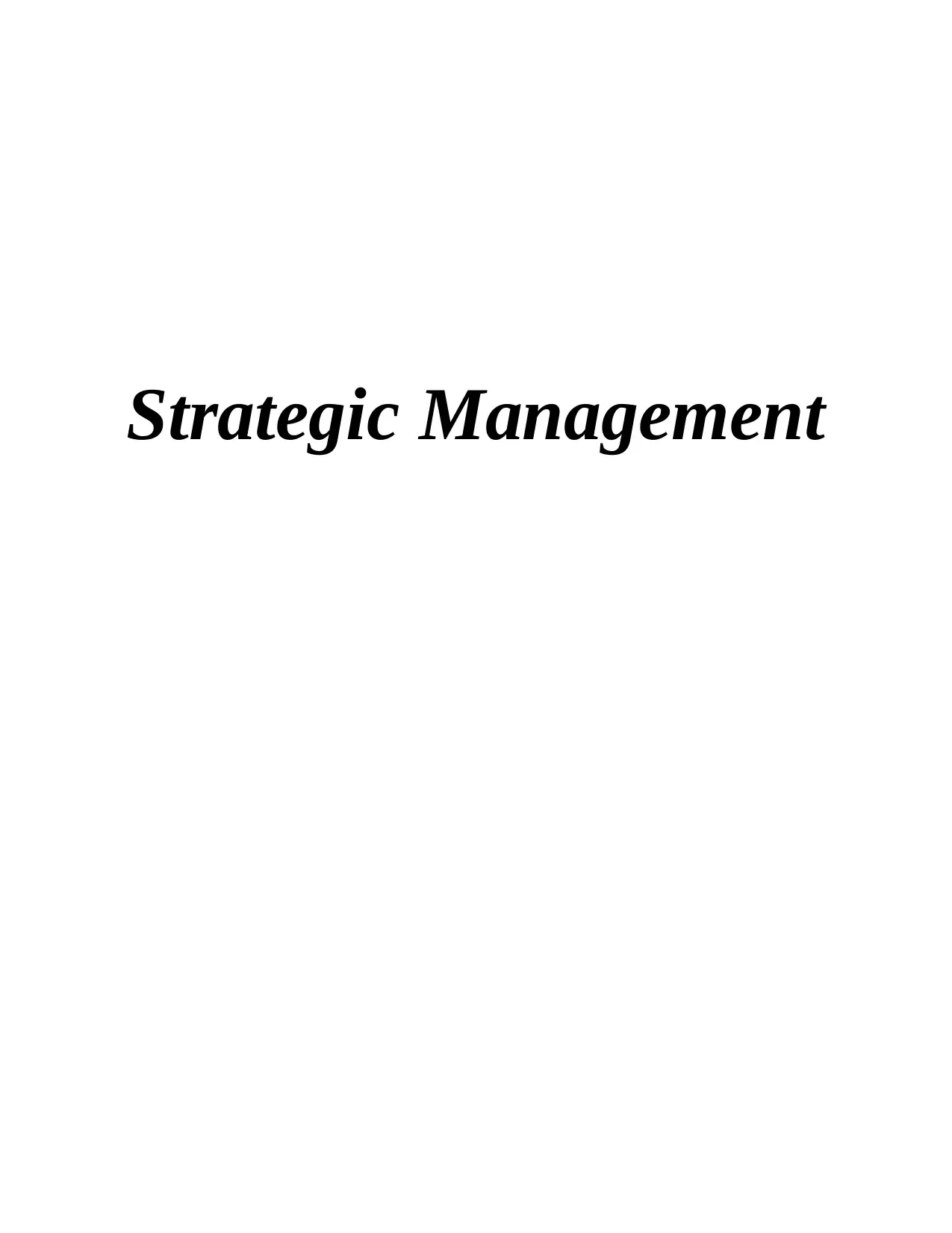
Strategic Management
Paraphrase This Document
Need a fresh take? Get an instant paraphrase of this document with our AI Paraphraser
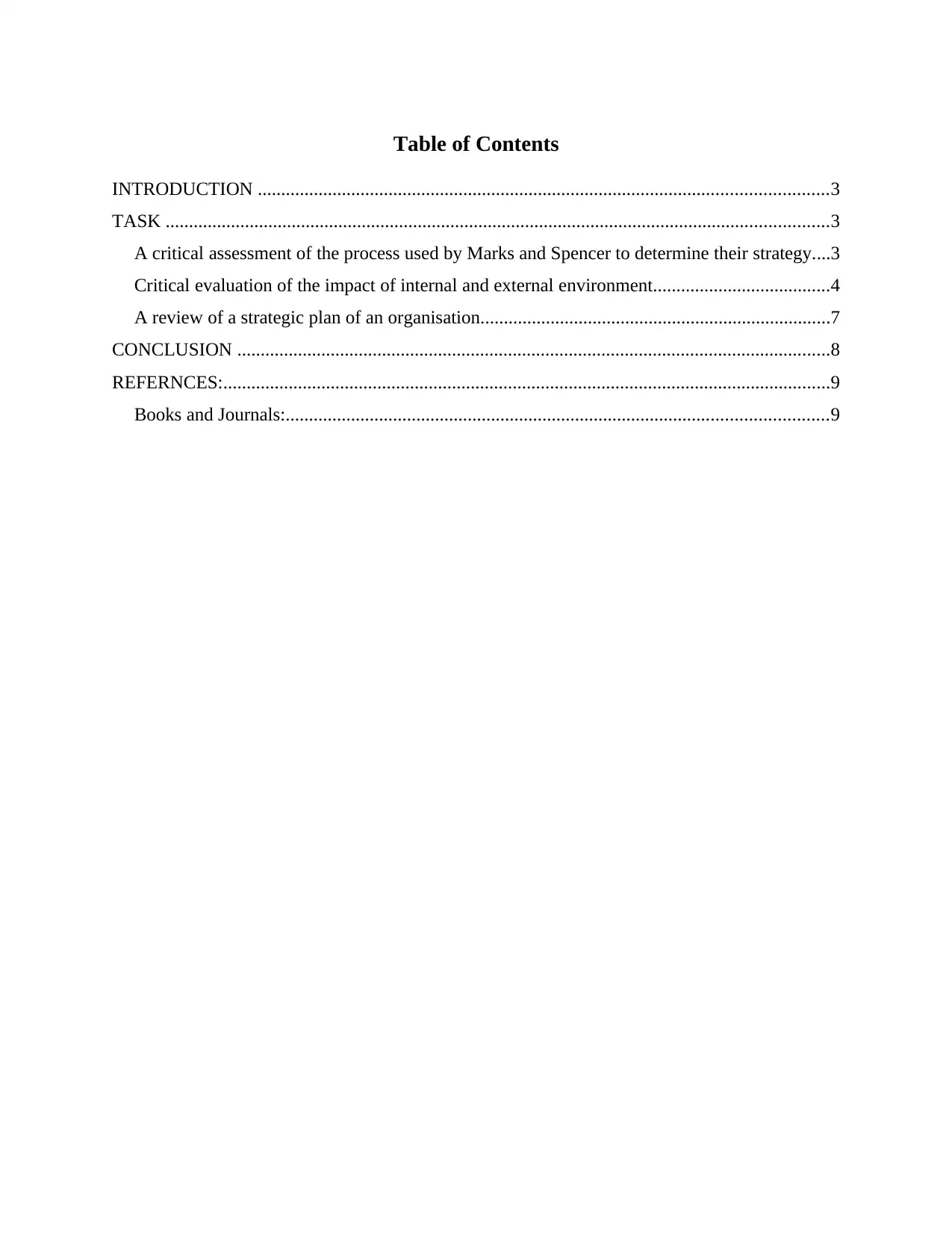
Table of Contents
INTRODUCTION ..........................................................................................................................3
TASK ..............................................................................................................................................3
A critical assessment of the process used by Marks and Spencer to determine their strategy....3
Critical evaluation of the impact of internal and external environment......................................4
A review of a strategic plan of an organisation...........................................................................7
CONCLUSION ...............................................................................................................................8
REFERNCES:..................................................................................................................................9
Books and Journals:....................................................................................................................9
INTRODUCTION ..........................................................................................................................3
TASK ..............................................................................................................................................3
A critical assessment of the process used by Marks and Spencer to determine their strategy....3
Critical evaluation of the impact of internal and external environment......................................4
A review of a strategic plan of an organisation...........................................................................7
CONCLUSION ...............................................................................................................................8
REFERNCES:..................................................................................................................................9
Books and Journals:....................................................................................................................9
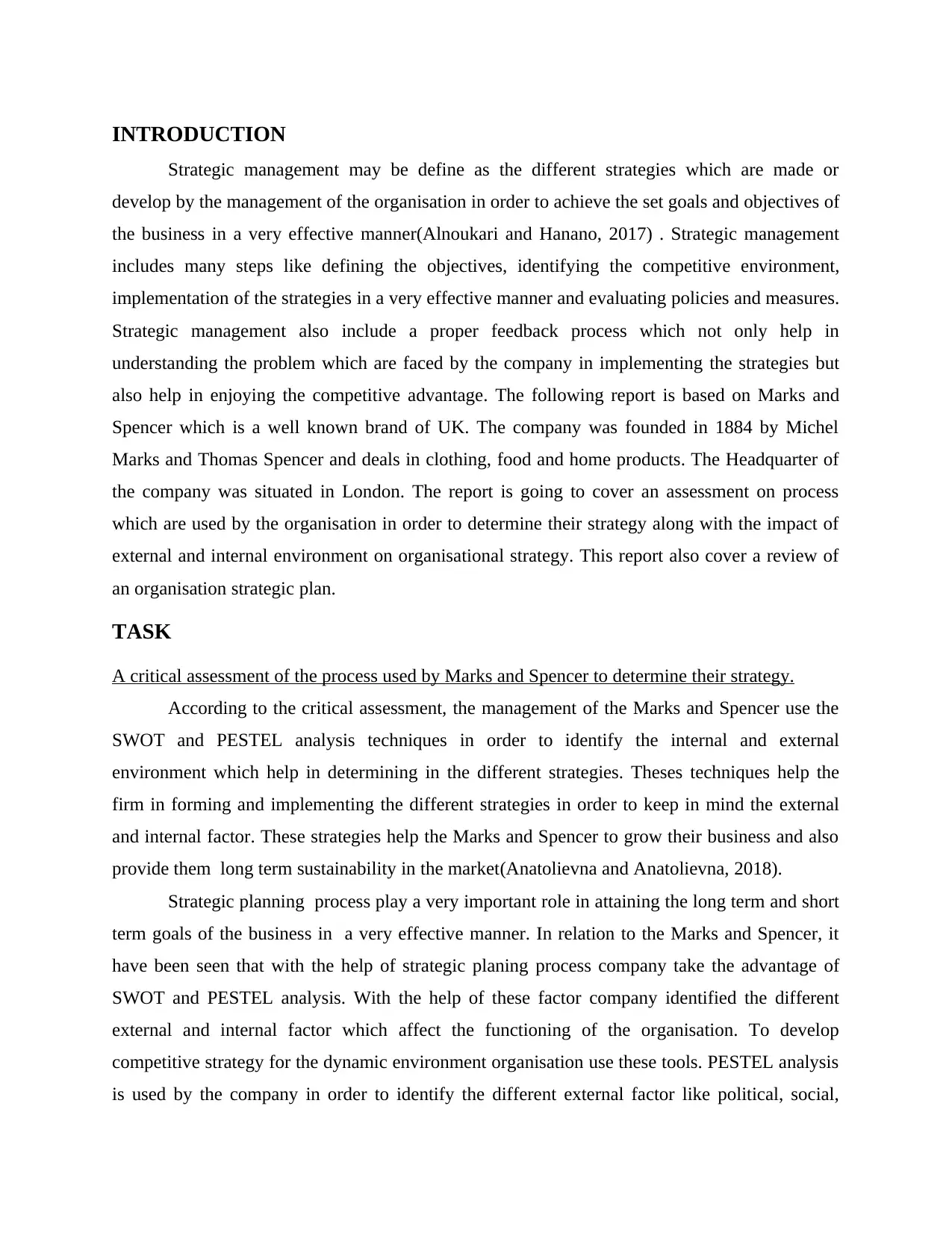
INTRODUCTION
Strategic management may be define as the different strategies which are made or
develop by the management of the organisation in order to achieve the set goals and objectives of
the business in a very effective manner(Alnoukari and Hanano, 2017) . Strategic management
includes many steps like defining the objectives, identifying the competitive environment,
implementation of the strategies in a very effective manner and evaluating policies and measures.
Strategic management also include a proper feedback process which not only help in
understanding the problem which are faced by the company in implementing the strategies but
also help in enjoying the competitive advantage. The following report is based on Marks and
Spencer which is a well known brand of UK. The company was founded in 1884 by Michel
Marks and Thomas Spencer and deals in clothing, food and home products. The Headquarter of
the company was situated in London. The report is going to cover an assessment on process
which are used by the organisation in order to determine their strategy along with the impact of
external and internal environment on organisational strategy. This report also cover a review of
an organisation strategic plan.
TASK
A critical assessment of the process used by Marks and Spencer to determine their strategy.
According to the critical assessment, the management of the Marks and Spencer use the
SWOT and PESTEL analysis techniques in order to identify the internal and external
environment which help in determining in the different strategies. Theses techniques help the
firm in forming and implementing the different strategies in order to keep in mind the external
and internal factor. These strategies help the Marks and Spencer to grow their business and also
provide them long term sustainability in the market(Anatolievna and Anatolievna, 2018).
Strategic planning process play a very important role in attaining the long term and short
term goals of the business in a very effective manner. In relation to the Marks and Spencer, it
have been seen that with the help of strategic planing process company take the advantage of
SWOT and PESTEL analysis. With the help of these factor company identified the different
external and internal factor which affect the functioning of the organisation. To develop
competitive strategy for the dynamic environment organisation use these tools. PESTEL analysis
is used by the company in order to identify the different external factor like political, social,
Strategic management may be define as the different strategies which are made or
develop by the management of the organisation in order to achieve the set goals and objectives of
the business in a very effective manner(Alnoukari and Hanano, 2017) . Strategic management
includes many steps like defining the objectives, identifying the competitive environment,
implementation of the strategies in a very effective manner and evaluating policies and measures.
Strategic management also include a proper feedback process which not only help in
understanding the problem which are faced by the company in implementing the strategies but
also help in enjoying the competitive advantage. The following report is based on Marks and
Spencer which is a well known brand of UK. The company was founded in 1884 by Michel
Marks and Thomas Spencer and deals in clothing, food and home products. The Headquarter of
the company was situated in London. The report is going to cover an assessment on process
which are used by the organisation in order to determine their strategy along with the impact of
external and internal environment on organisational strategy. This report also cover a review of
an organisation strategic plan.
TASK
A critical assessment of the process used by Marks and Spencer to determine their strategy.
According to the critical assessment, the management of the Marks and Spencer use the
SWOT and PESTEL analysis techniques in order to identify the internal and external
environment which help in determining in the different strategies. Theses techniques help the
firm in forming and implementing the different strategies in order to keep in mind the external
and internal factor. These strategies help the Marks and Spencer to grow their business and also
provide them long term sustainability in the market(Anatolievna and Anatolievna, 2018).
Strategic planning process play a very important role in attaining the long term and short
term goals of the business in a very effective manner. In relation to the Marks and Spencer, it
have been seen that with the help of strategic planing process company take the advantage of
SWOT and PESTEL analysis. With the help of these factor company identified the different
external and internal factor which affect the functioning of the organisation. To develop
competitive strategy for the dynamic environment organisation use these tools. PESTEL analysis
is used by the company in order to identify the different external factor like political, social,
⊘ This is a preview!⊘
Do you want full access?
Subscribe today to unlock all pages.

Trusted by 1+ million students worldwide
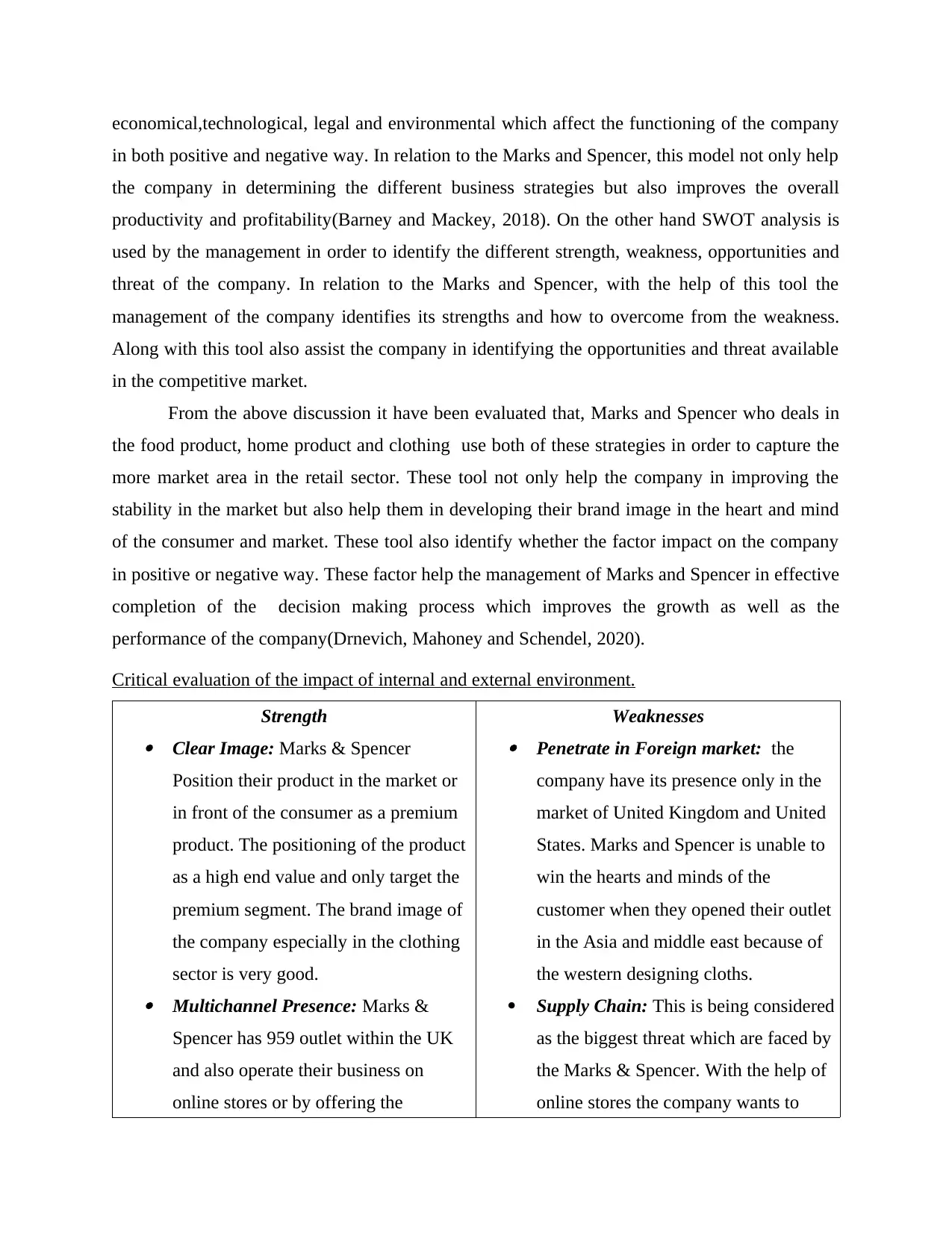
economical,technological, legal and environmental which affect the functioning of the company
in both positive and negative way. In relation to the Marks and Spencer, this model not only help
the company in determining the different business strategies but also improves the overall
productivity and profitability(Barney and Mackey, 2018). On the other hand SWOT analysis is
used by the management in order to identify the different strength, weakness, opportunities and
threat of the company. In relation to the Marks and Spencer, with the help of this tool the
management of the company identifies its strengths and how to overcome from the weakness.
Along with this tool also assist the company in identifying the opportunities and threat available
in the competitive market.
From the above discussion it have been evaluated that, Marks and Spencer who deals in
the food product, home product and clothing use both of these strategies in order to capture the
more market area in the retail sector. These tool not only help the company in improving the
stability in the market but also help them in developing their brand image in the heart and mind
of the consumer and market. These tool also identify whether the factor impact on the company
in positive or negative way. These factor help the management of Marks and Spencer in effective
completion of the decision making process which improves the growth as well as the
performance of the company(Drnevich, Mahoney and Schendel, 2020).
Critical evaluation of the impact of internal and external environment.
Strength Clear Image: Marks & Spencer
Position their product in the market or
in front of the consumer as a premium
product. The positioning of the product
as a high end value and only target the
premium segment. The brand image of
the company especially in the clothing
sector is very good. Multichannel Presence: Marks &
Spencer has 959 outlet within the UK
and also operate their business on
online stores or by offering the
Weaknesses
Penetrate in Foreign market: the
company have its presence only in the
market of United Kingdom and United
States. Marks and Spencer is unable to
win the hearts and minds of the
customer when they opened their outlet
in the Asia and middle east because of
the western designing cloths.
Supply Chain: This is being considered
as the biggest threat which are faced by
the Marks & Spencer. With the help of
online stores the company wants to
in both positive and negative way. In relation to the Marks and Spencer, this model not only help
the company in determining the different business strategies but also improves the overall
productivity and profitability(Barney and Mackey, 2018). On the other hand SWOT analysis is
used by the management in order to identify the different strength, weakness, opportunities and
threat of the company. In relation to the Marks and Spencer, with the help of this tool the
management of the company identifies its strengths and how to overcome from the weakness.
Along with this tool also assist the company in identifying the opportunities and threat available
in the competitive market.
From the above discussion it have been evaluated that, Marks and Spencer who deals in
the food product, home product and clothing use both of these strategies in order to capture the
more market area in the retail sector. These tool not only help the company in improving the
stability in the market but also help them in developing their brand image in the heart and mind
of the consumer and market. These tool also identify whether the factor impact on the company
in positive or negative way. These factor help the management of Marks and Spencer in effective
completion of the decision making process which improves the growth as well as the
performance of the company(Drnevich, Mahoney and Schendel, 2020).
Critical evaluation of the impact of internal and external environment.
Strength Clear Image: Marks & Spencer
Position their product in the market or
in front of the consumer as a premium
product. The positioning of the product
as a high end value and only target the
premium segment. The brand image of
the company especially in the clothing
sector is very good. Multichannel Presence: Marks &
Spencer has 959 outlet within the UK
and also operate their business on
online stores or by offering the
Weaknesses
Penetrate in Foreign market: the
company have its presence only in the
market of United Kingdom and United
States. Marks and Spencer is unable to
win the hearts and minds of the
customer when they opened their outlet
in the Asia and middle east because of
the western designing cloths.
Supply Chain: This is being considered
as the biggest threat which are faced by
the Marks & Spencer. With the help of
online stores the company wants to
Paraphrase This Document
Need a fresh take? Get an instant paraphrase of this document with our AI Paraphraser
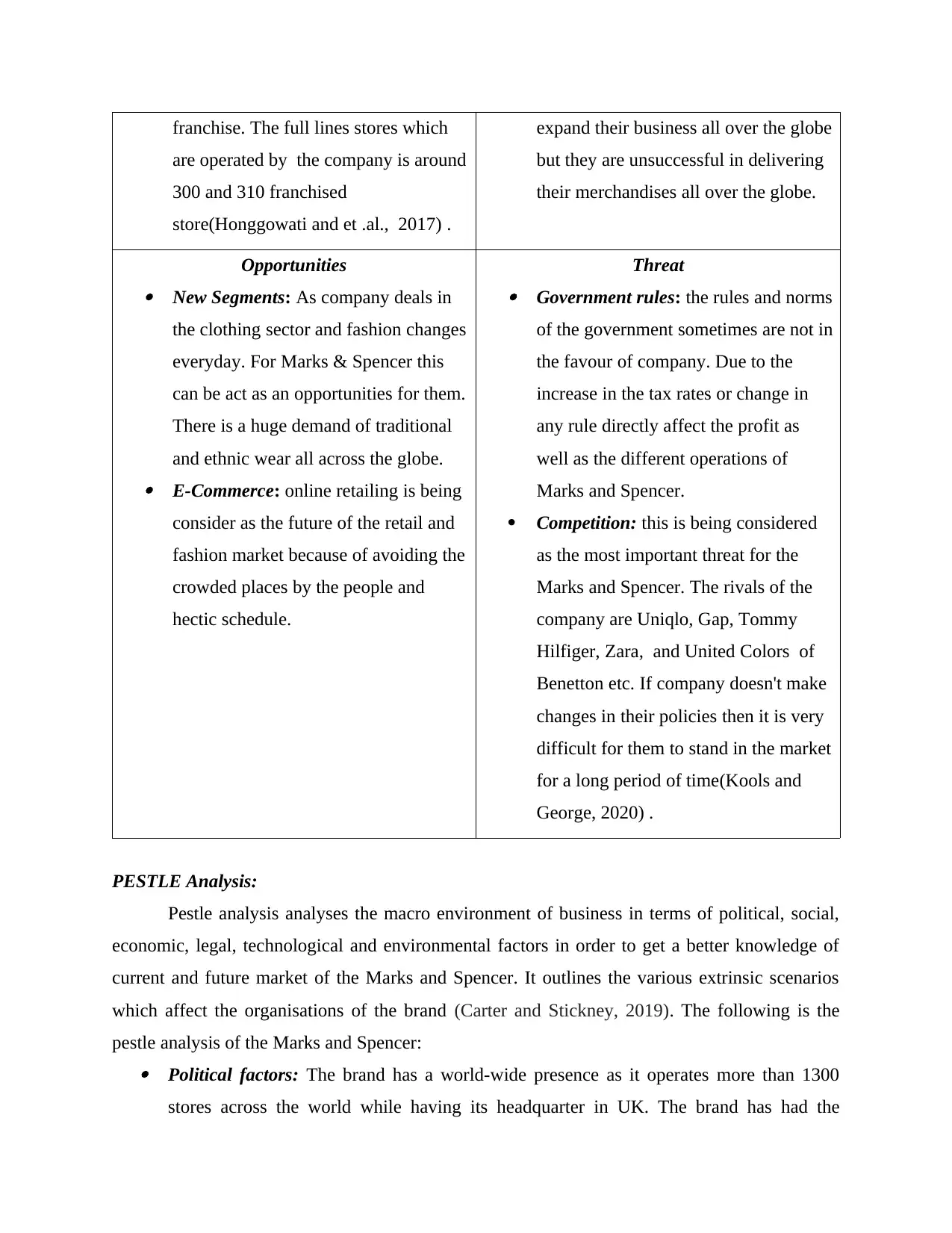
franchise. The full lines stores which
are operated by the company is around
300 and 310 franchised
store(Honggowati and et .al., 2017) .
expand their business all over the globe
but they are unsuccessful in delivering
their merchandises all over the globe.
Opportunities New Segments: As company deals in
the clothing sector and fashion changes
everyday. For Marks & Spencer this
can be act as an opportunities for them.
There is a huge demand of traditional
and ethnic wear all across the globe. E-Commerce: online retailing is being
consider as the future of the retail and
fashion market because of avoiding the
crowded places by the people and
hectic schedule.
Threat
Government rules: the rules and norms
of the government sometimes are not in
the favour of company. Due to the
increase in the tax rates or change in
any rule directly affect the profit as
well as the different operations of
Marks and Spencer.
Competition: this is being considered
as the most important threat for the
Marks and Spencer. The rivals of the
company are Uniqlo, Gap, Tommy
Hilfiger, Zara, and United Colors of
Benetton etc. If company doesn't make
changes in their policies then it is very
difficult for them to stand in the market
for a long period of time(Kools and
George, 2020) .
PESTLE Analysis:
Pestle analysis analyses the macro environment of business in terms of political, social,
economic, legal, technological and environmental factors in order to get a better knowledge of
current and future market of the Marks and Spencer. It outlines the various extrinsic scenarios
which affect the organisations of the brand (Carter and Stickney, 2019). The following is the
pestle analysis of the Marks and Spencer: Political factors: The brand has a world-wide presence as it operates more than 1300
stores across the world while having its headquarter in UK. The brand has had the
are operated by the company is around
300 and 310 franchised
store(Honggowati and et .al., 2017) .
expand their business all over the globe
but they are unsuccessful in delivering
their merchandises all over the globe.
Opportunities New Segments: As company deals in
the clothing sector and fashion changes
everyday. For Marks & Spencer this
can be act as an opportunities for them.
There is a huge demand of traditional
and ethnic wear all across the globe. E-Commerce: online retailing is being
consider as the future of the retail and
fashion market because of avoiding the
crowded places by the people and
hectic schedule.
Threat
Government rules: the rules and norms
of the government sometimes are not in
the favour of company. Due to the
increase in the tax rates or change in
any rule directly affect the profit as
well as the different operations of
Marks and Spencer.
Competition: this is being considered
as the most important threat for the
Marks and Spencer. The rivals of the
company are Uniqlo, Gap, Tommy
Hilfiger, Zara, and United Colors of
Benetton etc. If company doesn't make
changes in their policies then it is very
difficult for them to stand in the market
for a long period of time(Kools and
George, 2020) .
PESTLE Analysis:
Pestle analysis analyses the macro environment of business in terms of political, social,
economic, legal, technological and environmental factors in order to get a better knowledge of
current and future market of the Marks and Spencer. It outlines the various extrinsic scenarios
which affect the organisations of the brand (Carter and Stickney, 2019). The following is the
pestle analysis of the Marks and Spencer: Political factors: The brand has a world-wide presence as it operates more than 1300
stores across the world while having its headquarter in UK. The brand has had the
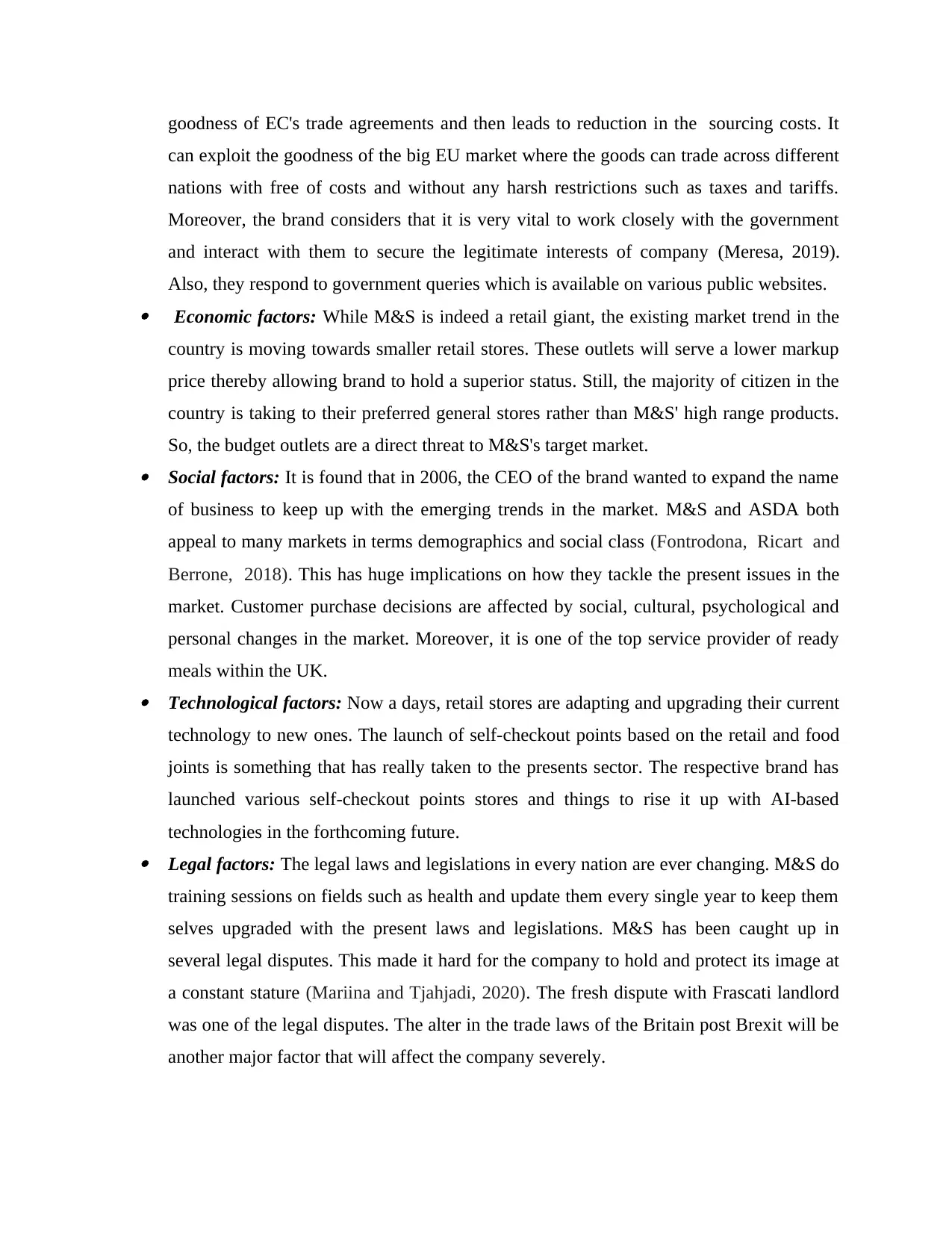
goodness of EC's trade agreements and then leads to reduction in the sourcing costs. It
can exploit the goodness of the big EU market where the goods can trade across different
nations with free of costs and without any harsh restrictions such as taxes and tariffs.
Moreover, the brand considers that it is very vital to work closely with the government
and interact with them to secure the legitimate interests of company (Meresa, 2019).
Also, they respond to government queries which is available on various public websites. Economic factors: While M&S is indeed a retail giant, the existing market trend in the
country is moving towards smaller retail stores. These outlets will serve a lower markup
price thereby allowing brand to hold a superior status. Still, the majority of citizen in the
country is taking to their preferred general stores rather than M&S' high range products.
So, the budget outlets are a direct threat to M&S's target market. Social factors: It is found that in 2006, the CEO of the brand wanted to expand the name
of business to keep up with the emerging trends in the market. M&S and ASDA both
appeal to many markets in terms demographics and social class (Fontrodona, Ricart and
Berrone, 2018). This has huge implications on how they tackle the present issues in the
market. Customer purchase decisions are affected by social, cultural, psychological and
personal changes in the market. Moreover, it is one of the top service provider of ready
meals within the UK. Technological factors: Now a days, retail stores are adapting and upgrading their current
technology to new ones. The launch of self-checkout points based on the retail and food
joints is something that has really taken to the presents sector. The respective brand has
launched various self-checkout points stores and things to rise it up with AI-based
technologies in the forthcoming future. Legal factors: The legal laws and legislations in every nation are ever changing. M&S do
training sessions on fields such as health and update them every single year to keep them
selves upgraded with the present laws and legislations. M&S has been caught up in
several legal disputes. This made it hard for the company to hold and protect its image at
a constant stature (Mariina and Tjahjadi, 2020). The fresh dispute with Frascati landlord
was one of the legal disputes. The alter in the trade laws of the Britain post Brexit will be
another major factor that will affect the company severely.
can exploit the goodness of the big EU market where the goods can trade across different
nations with free of costs and without any harsh restrictions such as taxes and tariffs.
Moreover, the brand considers that it is very vital to work closely with the government
and interact with them to secure the legitimate interests of company (Meresa, 2019).
Also, they respond to government queries which is available on various public websites. Economic factors: While M&S is indeed a retail giant, the existing market trend in the
country is moving towards smaller retail stores. These outlets will serve a lower markup
price thereby allowing brand to hold a superior status. Still, the majority of citizen in the
country is taking to their preferred general stores rather than M&S' high range products.
So, the budget outlets are a direct threat to M&S's target market. Social factors: It is found that in 2006, the CEO of the brand wanted to expand the name
of business to keep up with the emerging trends in the market. M&S and ASDA both
appeal to many markets in terms demographics and social class (Fontrodona, Ricart and
Berrone, 2018). This has huge implications on how they tackle the present issues in the
market. Customer purchase decisions are affected by social, cultural, psychological and
personal changes in the market. Moreover, it is one of the top service provider of ready
meals within the UK. Technological factors: Now a days, retail stores are adapting and upgrading their current
technology to new ones. The launch of self-checkout points based on the retail and food
joints is something that has really taken to the presents sector. The respective brand has
launched various self-checkout points stores and things to rise it up with AI-based
technologies in the forthcoming future. Legal factors: The legal laws and legislations in every nation are ever changing. M&S do
training sessions on fields such as health and update them every single year to keep them
selves upgraded with the present laws and legislations. M&S has been caught up in
several legal disputes. This made it hard for the company to hold and protect its image at
a constant stature (Mariina and Tjahjadi, 2020). The fresh dispute with Frascati landlord
was one of the legal disputes. The alter in the trade laws of the Britain post Brexit will be
another major factor that will affect the company severely.
⊘ This is a preview!⊘
Do you want full access?
Subscribe today to unlock all pages.

Trusted by 1+ million students worldwide
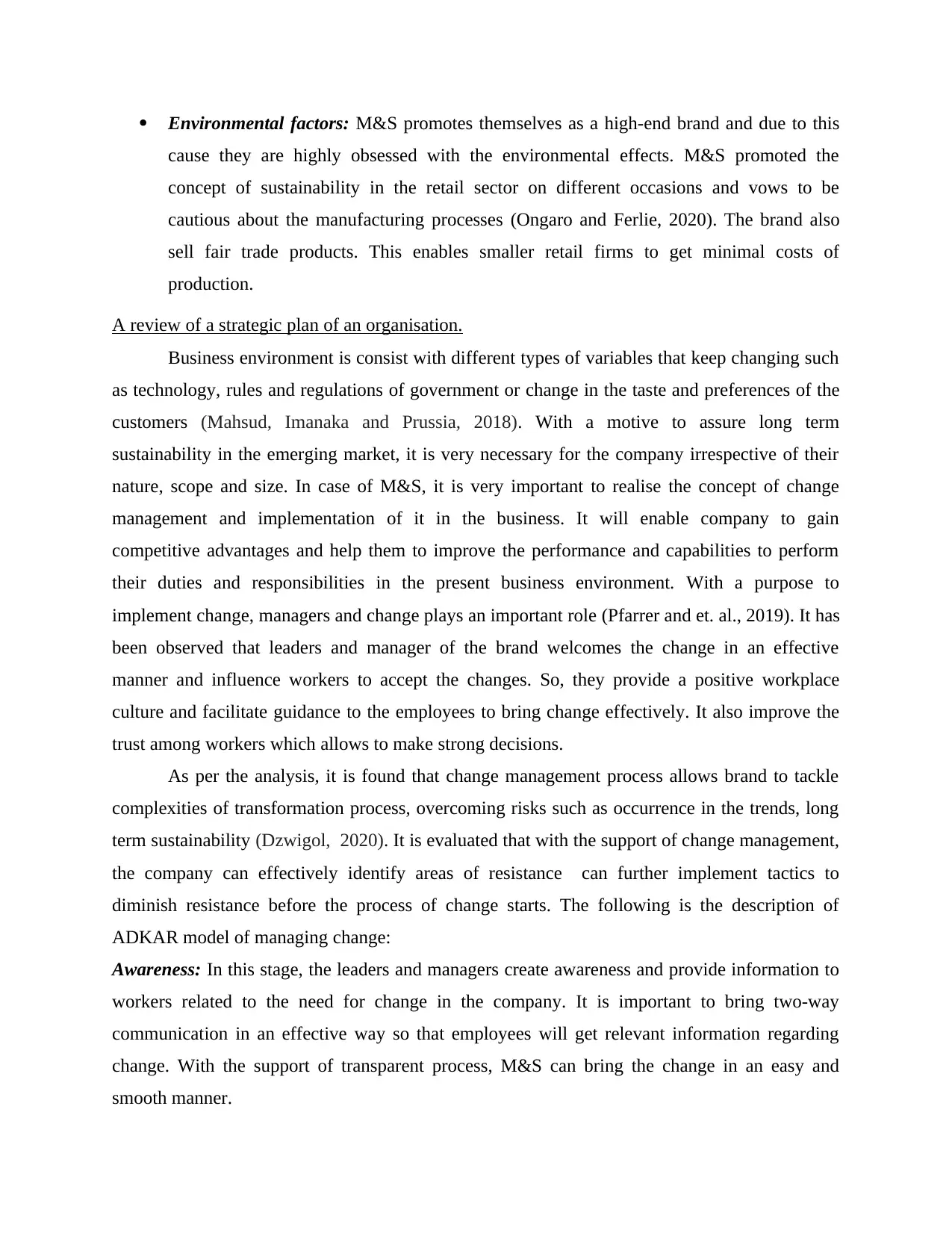
Environmental factors: M&S promotes themselves as a high-end brand and due to this
cause they are highly obsessed with the environmental effects. M&S promoted the
concept of sustainability in the retail sector on different occasions and vows to be
cautious about the manufacturing processes (Ongaro and Ferlie, 2020). The brand also
sell fair trade products. This enables smaller retail firms to get minimal costs of
production.
A review of a strategic plan of an organisation.
Business environment is consist with different types of variables that keep changing such
as technology, rules and regulations of government or change in the taste and preferences of the
customers (Mahsud, Imanaka and Prussia, 2018). With a motive to assure long term
sustainability in the emerging market, it is very necessary for the company irrespective of their
nature, scope and size. In case of M&S, it is very important to realise the concept of change
management and implementation of it in the business. It will enable company to gain
competitive advantages and help them to improve the performance and capabilities to perform
their duties and responsibilities in the present business environment. With a purpose to
implement change, managers and change plays an important role (Pfarrer and et. al., 2019). It has
been observed that leaders and manager of the brand welcomes the change in an effective
manner and influence workers to accept the changes. So, they provide a positive workplace
culture and facilitate guidance to the employees to bring change effectively. It also improve the
trust among workers which allows to make strong decisions.
As per the analysis, it is found that change management process allows brand to tackle
complexities of transformation process, overcoming risks such as occurrence in the trends, long
term sustainability (Dzwigol, 2020). It is evaluated that with the support of change management,
the company can effectively identify areas of resistance can further implement tactics to
diminish resistance before the process of change starts. The following is the description of
ADKAR model of managing change:
Awareness: In this stage, the leaders and managers create awareness and provide information to
workers related to the need for change in the company. It is important to bring two-way
communication in an effective way so that employees will get relevant information regarding
change. With the support of transparent process, M&S can bring the change in an easy and
smooth manner.
cause they are highly obsessed with the environmental effects. M&S promoted the
concept of sustainability in the retail sector on different occasions and vows to be
cautious about the manufacturing processes (Ongaro and Ferlie, 2020). The brand also
sell fair trade products. This enables smaller retail firms to get minimal costs of
production.
A review of a strategic plan of an organisation.
Business environment is consist with different types of variables that keep changing such
as technology, rules and regulations of government or change in the taste and preferences of the
customers (Mahsud, Imanaka and Prussia, 2018). With a motive to assure long term
sustainability in the emerging market, it is very necessary for the company irrespective of their
nature, scope and size. In case of M&S, it is very important to realise the concept of change
management and implementation of it in the business. It will enable company to gain
competitive advantages and help them to improve the performance and capabilities to perform
their duties and responsibilities in the present business environment. With a purpose to
implement change, managers and change plays an important role (Pfarrer and et. al., 2019). It has
been observed that leaders and manager of the brand welcomes the change in an effective
manner and influence workers to accept the changes. So, they provide a positive workplace
culture and facilitate guidance to the employees to bring change effectively. It also improve the
trust among workers which allows to make strong decisions.
As per the analysis, it is found that change management process allows brand to tackle
complexities of transformation process, overcoming risks such as occurrence in the trends, long
term sustainability (Dzwigol, 2020). It is evaluated that with the support of change management,
the company can effectively identify areas of resistance can further implement tactics to
diminish resistance before the process of change starts. The following is the description of
ADKAR model of managing change:
Awareness: In this stage, the leaders and managers create awareness and provide information to
workers related to the need for change in the company. It is important to bring two-way
communication in an effective way so that employees will get relevant information regarding
change. With the support of transparent process, M&S can bring the change in an easy and
smooth manner.
Paraphrase This Document
Need a fresh take? Get an instant paraphrase of this document with our AI Paraphraser
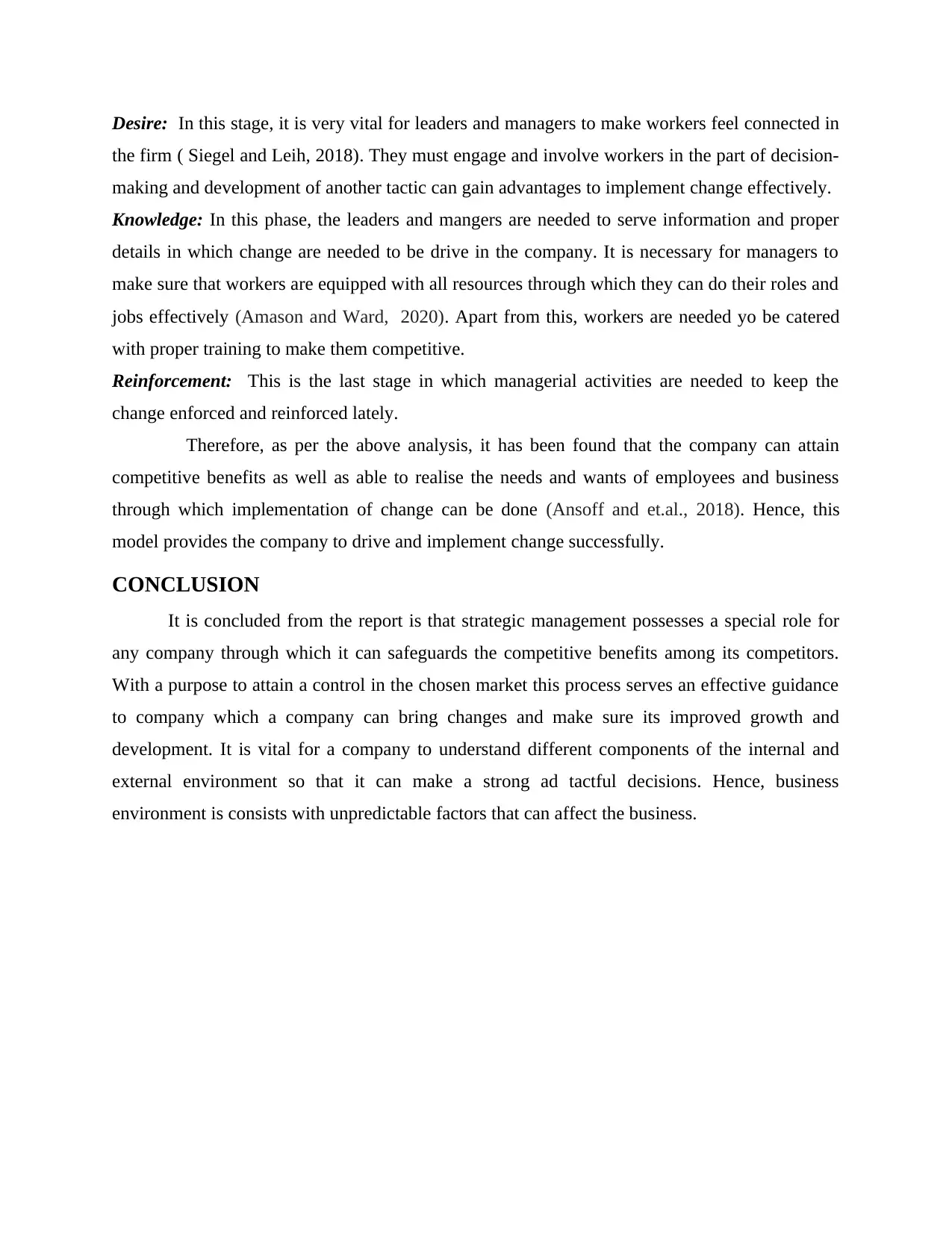
Desire: In this stage, it is very vital for leaders and managers to make workers feel connected in
the firm ( Siegel and Leih, 2018). They must engage and involve workers in the part of decision-
making and development of another tactic can gain advantages to implement change effectively.
Knowledge: In this phase, the leaders and mangers are needed to serve information and proper
details in which change are needed to be drive in the company. It is necessary for managers to
make sure that workers are equipped with all resources through which they can do their roles and
jobs effectively (Amason and Ward, 2020). Apart from this, workers are needed yo be catered
with proper training to make them competitive.
Reinforcement: This is the last stage in which managerial activities are needed to keep the
change enforced and reinforced lately.
Therefore, as per the above analysis, it has been found that the company can attain
competitive benefits as well as able to realise the needs and wants of employees and business
through which implementation of change can be done (Ansoff and et.al., 2018). Hence, this
model provides the company to drive and implement change successfully.
CONCLUSION
It is concluded from the report is that strategic management possesses a special role for
any company through which it can safeguards the competitive benefits among its competitors.
With a purpose to attain a control in the chosen market this process serves an effective guidance
to company which a company can bring changes and make sure its improved growth and
development. It is vital for a company to understand different components of the internal and
external environment so that it can make a strong ad tactful decisions. Hence, business
environment is consists with unpredictable factors that can affect the business.
the firm ( Siegel and Leih, 2018). They must engage and involve workers in the part of decision-
making and development of another tactic can gain advantages to implement change effectively.
Knowledge: In this phase, the leaders and mangers are needed to serve information and proper
details in which change are needed to be drive in the company. It is necessary for managers to
make sure that workers are equipped with all resources through which they can do their roles and
jobs effectively (Amason and Ward, 2020). Apart from this, workers are needed yo be catered
with proper training to make them competitive.
Reinforcement: This is the last stage in which managerial activities are needed to keep the
change enforced and reinforced lately.
Therefore, as per the above analysis, it has been found that the company can attain
competitive benefits as well as able to realise the needs and wants of employees and business
through which implementation of change can be done (Ansoff and et.al., 2018). Hence, this
model provides the company to drive and implement change successfully.
CONCLUSION
It is concluded from the report is that strategic management possesses a special role for
any company through which it can safeguards the competitive benefits among its competitors.
With a purpose to attain a control in the chosen market this process serves an effective guidance
to company which a company can bring changes and make sure its improved growth and
development. It is vital for a company to understand different components of the internal and
external environment so that it can make a strong ad tactful decisions. Hence, business
environment is consists with unpredictable factors that can affect the business.
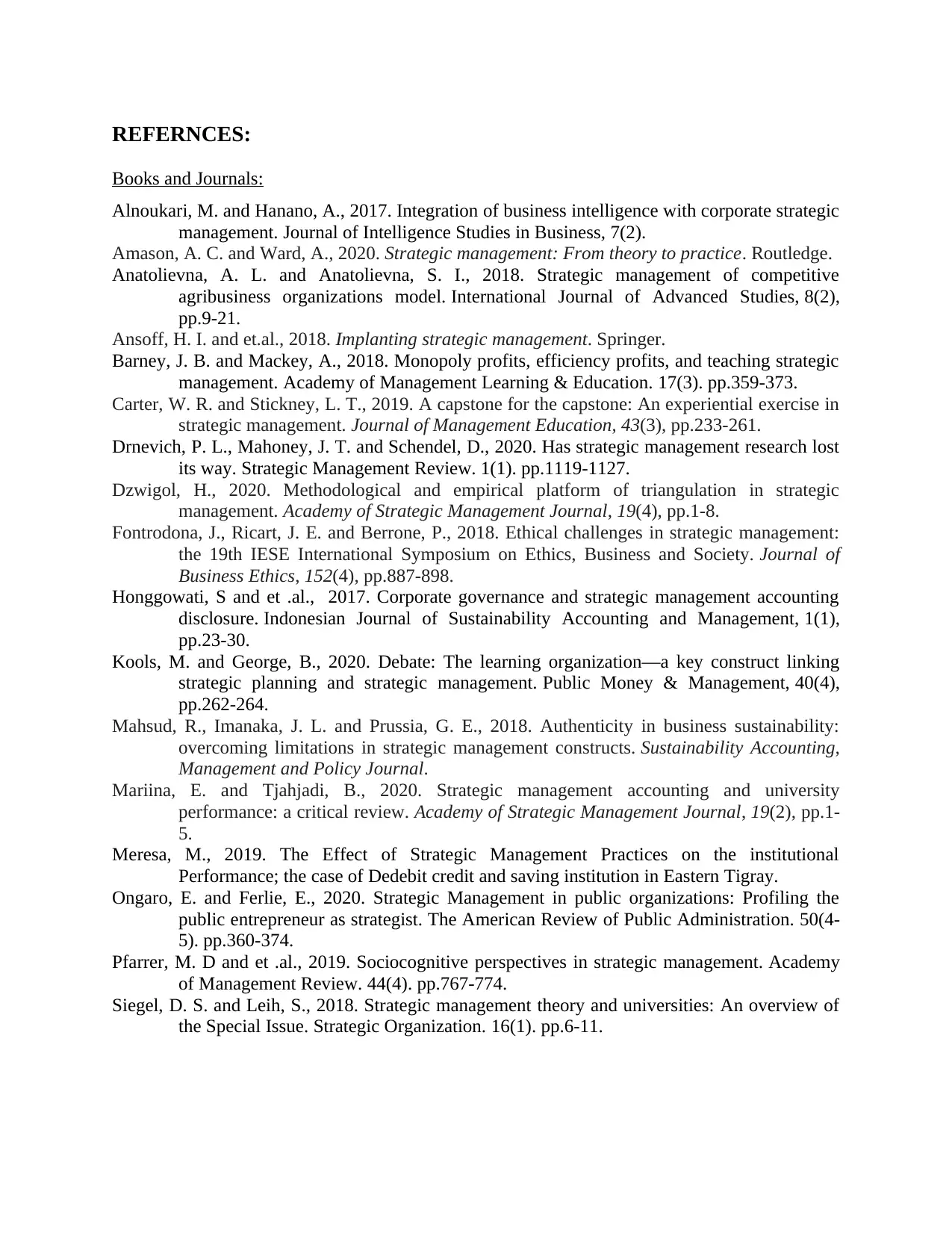
REFERNCES:
Books and Journals:
Alnoukari, M. and Hanano, A., 2017. Integration of business intelligence with corporate strategic
management. Journal of Intelligence Studies in Business, 7(2).
Amason, A. C. and Ward, A., 2020. Strategic management: From theory to practice. Routledge.
Anatolievna, A. L. and Anatolievna, S. I., 2018. Strategic management of competitive
agribusiness organizations model. International Journal of Advanced Studies, 8(2),
pp.9-21.
Ansoff, H. I. and et.al., 2018. Implanting strategic management. Springer.
Barney, J. B. and Mackey, A., 2018. Monopoly profits, efficiency profits, and teaching strategic
management. Academy of Management Learning & Education. 17(3). pp.359-373.
Carter, W. R. and Stickney, L. T., 2019. A capstone for the capstone: An experiential exercise in
strategic management. Journal of Management Education, 43(3), pp.233-261.
Drnevich, P. L., Mahoney, J. T. and Schendel, D., 2020. Has strategic management research lost
its way. Strategic Management Review. 1(1). pp.1119-1127.
Dzwigol, H., 2020. Methodological and empirical platform of triangulation in strategic
management. Academy of Strategic Management Journal, 19(4), pp.1-8.
Fontrodona, J., Ricart, J. E. and Berrone, P., 2018. Ethical challenges in strategic management:
the 19th IESE International Symposium on Ethics, Business and Society. Journal of
Business Ethics, 152(4), pp.887-898.
Honggowati, S and et .al., 2017. Corporate governance and strategic management accounting
disclosure. Indonesian Journal of Sustainability Accounting and Management, 1(1),
pp.23-30.
Kools, M. and George, B., 2020. Debate: The learning organization—a key construct linking
strategic planning and strategic management. Public Money & Management, 40(4),
pp.262-264.
Mahsud, R., Imanaka, J. L. and Prussia, G. E., 2018. Authenticity in business sustainability:
overcoming limitations in strategic management constructs. Sustainability Accounting,
Management and Policy Journal.
Mariina, E. and Tjahjadi, B., 2020. Strategic management accounting and university
performance: a critical review. Academy of Strategic Management Journal, 19(2), pp.1-
5.
Meresa, M., 2019. The Effect of Strategic Management Practices on the institutional
Performance; the case of Dedebit credit and saving institution in Eastern Tigray.
Ongaro, E. and Ferlie, E., 2020. Strategic Management in public organizations: Profiling the
public entrepreneur as strategist. The American Review of Public Administration. 50(4-
5). pp.360-374.
Pfarrer, M. D and et .al., 2019. Sociocognitive perspectives in strategic management. Academy
of Management Review. 44(4). pp.767-774.
Siegel, D. S. and Leih, S., 2018. Strategic management theory and universities: An overview of
the Special Issue. Strategic Organization. 16(1). pp.6-11.
Books and Journals:
Alnoukari, M. and Hanano, A., 2017. Integration of business intelligence with corporate strategic
management. Journal of Intelligence Studies in Business, 7(2).
Amason, A. C. and Ward, A., 2020. Strategic management: From theory to practice. Routledge.
Anatolievna, A. L. and Anatolievna, S. I., 2018. Strategic management of competitive
agribusiness organizations model. International Journal of Advanced Studies, 8(2),
pp.9-21.
Ansoff, H. I. and et.al., 2018. Implanting strategic management. Springer.
Barney, J. B. and Mackey, A., 2018. Monopoly profits, efficiency profits, and teaching strategic
management. Academy of Management Learning & Education. 17(3). pp.359-373.
Carter, W. R. and Stickney, L. T., 2019. A capstone for the capstone: An experiential exercise in
strategic management. Journal of Management Education, 43(3), pp.233-261.
Drnevich, P. L., Mahoney, J. T. and Schendel, D., 2020. Has strategic management research lost
its way. Strategic Management Review. 1(1). pp.1119-1127.
Dzwigol, H., 2020. Methodological and empirical platform of triangulation in strategic
management. Academy of Strategic Management Journal, 19(4), pp.1-8.
Fontrodona, J., Ricart, J. E. and Berrone, P., 2018. Ethical challenges in strategic management:
the 19th IESE International Symposium on Ethics, Business and Society. Journal of
Business Ethics, 152(4), pp.887-898.
Honggowati, S and et .al., 2017. Corporate governance and strategic management accounting
disclosure. Indonesian Journal of Sustainability Accounting and Management, 1(1),
pp.23-30.
Kools, M. and George, B., 2020. Debate: The learning organization—a key construct linking
strategic planning and strategic management. Public Money & Management, 40(4),
pp.262-264.
Mahsud, R., Imanaka, J. L. and Prussia, G. E., 2018. Authenticity in business sustainability:
overcoming limitations in strategic management constructs. Sustainability Accounting,
Management and Policy Journal.
Mariina, E. and Tjahjadi, B., 2020. Strategic management accounting and university
performance: a critical review. Academy of Strategic Management Journal, 19(2), pp.1-
5.
Meresa, M., 2019. The Effect of Strategic Management Practices on the institutional
Performance; the case of Dedebit credit and saving institution in Eastern Tigray.
Ongaro, E. and Ferlie, E., 2020. Strategic Management in public organizations: Profiling the
public entrepreneur as strategist. The American Review of Public Administration. 50(4-
5). pp.360-374.
Pfarrer, M. D and et .al., 2019. Sociocognitive perspectives in strategic management. Academy
of Management Review. 44(4). pp.767-774.
Siegel, D. S. and Leih, S., 2018. Strategic management theory and universities: An overview of
the Special Issue. Strategic Organization. 16(1). pp.6-11.
⊘ This is a preview!⊘
Do you want full access?
Subscribe today to unlock all pages.

Trusted by 1+ million students worldwide
1 out of 9
Related Documents
Your All-in-One AI-Powered Toolkit for Academic Success.
+13062052269
info@desklib.com
Available 24*7 on WhatsApp / Email
![[object Object]](/_next/static/media/star-bottom.7253800d.svg)
Unlock your academic potential
Copyright © 2020–2025 A2Z Services. All Rights Reserved. Developed and managed by ZUCOL.


